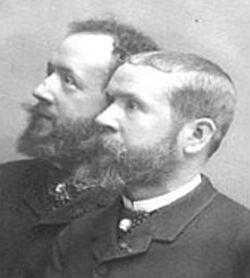21
Up, Up, Up and Away
Posted by jns on 21 May 2009 These are Les Frères Tissandier,* the brothers Albert Tissandier (1839-1906) on the left, and Gaston Tissandier (1843-1899). Albert was the artist, known as an illustrator, and Gaston was the scientist and aviator.†
These are Les Frères Tissandier,* the brothers Albert Tissandier (1839-1906) on the left, and Gaston Tissandier (1843-1899). Albert was the artist, known as an illustrator, and Gaston was the scientist and aviator.†
The Tissandier Brothers were pioneering adventurers (only Gaston did the flying) in high-altitude balloon ascensions. From the U.S. Centennial of Flight Commission’s “The Race to the Stratosphere“:
During the nineteenth century, balloonists had blazed a trail into the upper air, sometimes with tragic results. In 1862 Henry Coxwell and James Glaisher almost died at 30,000 feet (9,144 meters). Sivel and Croc.-Spinelli, who ascended in the balloon Zénith in April 1875 with balloonist Gaston Tissandier, died from oxygen deprivation. The last men of the era of the nineteenth century to dare altitudes over 30,000 feet (9,144 meters) were Herr Berson and Professor Süring of the Prussian Meteorological Institute, who ascended to 35,500 feet (10,820 meters) in 1901, a record that stood until 1931.
The first men to reach 30,000 feet (9,144 meters) did not know what they were facing. It is now known that at an altitude of only 10,000 feet (3,048 meters), the brain loses 10 percent of the oxygen it needs and judgment begins to falter. At 18,000 feet (5,486 feet), there is a 30 percent decrease in oxygen to the brain, and a person can lose consciousness in 30 minutes. At 30,000 feet (9,144 meters), loss of consciousness occurs in less than a minute without extra oxygen.
About that harrowing experience, here is Gaston’s account from his autobiography: Histoire de mes ascensions: recit de vingt-quatre voyage aériens (1868-1877).‡
I now come to the fateful moments when we were overcome by the terrible action of reduced pressure (lack of oxygen). At 22,900 feet torpor had seized me. I wrote nevertheless, though I have no clear recollection of writing. We are rising. Croce is panting. Sivel shuts his eyes. Croce also shuts his eyes. At 24,600 feet the condition of torpor that overcomes one is extraordinary. Body and mind become feebler. There is no suffering. On the contrary one feels an inward joy. There is no thought of the dangerous position; one rises and is glad to be rising. I soon felt myself so weak that I could not even turn my head to look at my companions. I wished to call out that we were now at 26,000, but my tongue was paralyzed. All at once I shut my eyes and fell down powerless and lost all further memory.
He lost consciousness and their balloon ultimately descended while he was unconscious. When he awoke it was to find his two companions dead.
Gaston wrote quite a number of books, over 17 according to his Wikipedia entry. The majority are about ballooning, but it seems that he also had a passion for photography, which was then in its infancy. In fact, several of his titles appear to be in print, including A History and Handbook of Photography.
From Project Gutenberg, two books by Gaston Tissandier are available:
- En ballon! Pendant le siege de Paris (link)
- La Navigation Aérienne L’aviation Et La Direction Des Aérostats Dans Les Temps Anciens Et Modernes (link)
For photographic entertainment, visit this site at the Library of Congress Tissandier Collection of 975 photographs, etchings, and other images emphasizing the early history of ballooning in France; about half of the images are digitized and online.
Finally, because I love research librarians, here is the Library of Congress’ Tracer Bullet on “Balloons and Airships“.
———-
* Crédit photo: Ministère de la Culture (France), Médiathèque de l’architecture et du patrimoine (archives photographiques) diffusion RMN / Référence: APNADAR022912 / Photograph by the studio of Nadar / source link.
† You may have detected the buoyant-flight theme that has preoccupied BoW for a couple of weeks. It’s because I recently read the very enjoyable Lighter than Air : An Illustrated History of Balloons and Airships, by Tom D. Crouch (Baltimore : Johns Hopkins University Press, in association with the Smithsonian National Air and Space Museum, 2009; 191 pages). My book note is here.
‡ From Indiana University’s Lilly Library, an online exhibit called “Conquest of the Skies: A History of Ballooning“, provides a chance to see images from Gaston Tissandier’s book Histoire de mes ascensions: recit de vingt-quatre voyage aériens (1868-1877) (“History of my [balloon] ascensions : accounts of 24 aerial trips”).